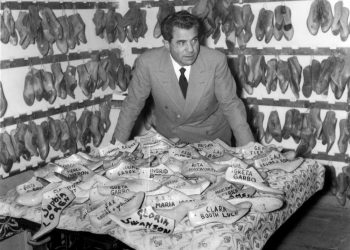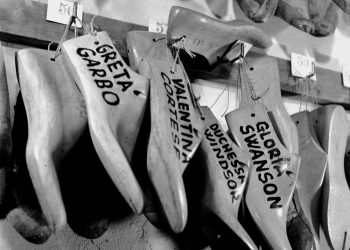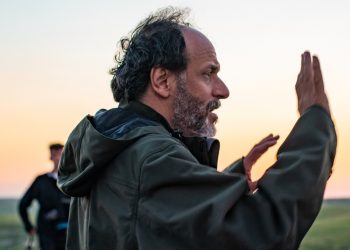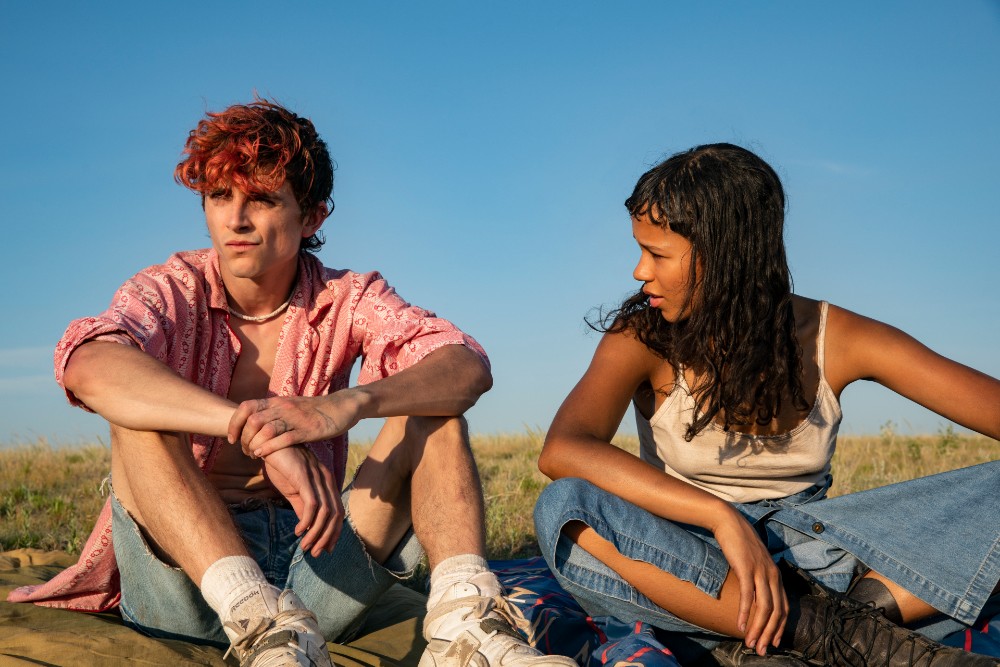Filmmaker Luca Guadagnino clearly likes to stay busy, or at least that’s one explanation why he has two new movies this month — the cannibal love story Bones and All and the documentary Salvatore: Shoemaker of Dreams, though the latter was actually completed a few years ago and premiered at the 2020 Venice Film Festival.
The Salvatore of the title is Salvatore Ferragamo, the legendary shoemaker and cobbler who in 1915 came to America at the age of 17, having already made a name for himself overseas. He convinced his brothers to move their shop to California, and shortly after arriving in Hollywood, Ferragamo became the go-to shoe manufacturer for the early days of cinema. He then moved back to Florence, Italy in 1927, while still making custom-fitted shoes for the likes of Marilyn Monroe and Eva Peron until his death in 1960.
Meanwhile, Guadagnino’s latest narrative film, Bones and All, is adapted from the novel by Camille DeAngelis, and it stars Timothée Chalamet (Dune) and Taylor Russell (Waves) as Lee and Maren, two “Eaters” who have a proclivity for consuming human flesh. Much of the film focuses on Maren’s journey across America, trying to find her long-absent mother. Along the way, she also encounters a few less-than-desirable cannibals, played by Oscar winner Mark Rylance and two-time Emmy nominee Michael Stuhlbarg. The latter, like Chalamet, first worked with Guadagnino on his Oscar-winning drama Call Me By Your Name, and Stuhlbarg also provides the narration for Salvatore.
Both films showcase a different side of Guadagnino, whose documentary work is extensive but not quite as well known in the States as his narrative films such as 2009’s I Am Love and 2015’s A Bigger Splash, both starring Tilda Swinton.
Above the Line spoke with Guadagnino via Zoom a few weeks back, shortly after Bones and All premiered at a number of fall film festivals. Even so, we began our conversation with Salvatore…

Above the Line: What was it about Ferragamo — his shoes or his life — that first got you interested in making a doc about him?
Luca Guadagnino: I very much loved the arc of his life from the South of Italy at the beginning of the last century to Hollywood, and back to Italy. I thought it was quite beautiful and charming.
ATL: How do you start a doc like this? Do you go to Ferragamo’s surviving family members first? Do you look for some footage? What was the first step?
Guadagnino: There was a book. He wrote a beautiful book called The Shoemaker of Dreams that I read and found exactly what I thought was inspiring. I approached the Ferragamo family. They also have a foundation and a museum that has a great archive, all about his legacy, and I talked to them, and they understood that my passion for Salvatore was real and that I really was committed, and that’s how it started. They completely understood my commitment to telling the story of Salvatore, and that I was the right person for it.
ATL: Did you sit down with them and interview them all first, or did you have people you worked with, researchers, to look for material? Where did the audio of him speaking come from?
Guadagnino: The Ferragamo family has a foundation in a museum, and in this museum, they have a beautiful trove of amazing materials. Salvatore himself was excellent [at] collecting everything that was related to his experiences — diaries, notes, drawings, inventions, plans, and films. He shot for a long time with a Super 8 camera — family movies, and also, his own voice, [which he] recorded for the actual writing of the book, or interviews that he [did]. They had so much. That was a beautiful experience to go into those archives and find so much, but at the same time, we’ve been blessed by being invited to many other archives, from the Italian National TV Archives to many other broadcasting archives from other countries, to the Dior archives, and so on and so on. The form of documentary is very different, and it’s about collecting a lot, and then focusing [in] the editing room [on] how to give shape to this.
ATL: What kind of shape were his home movies in? Did you or someone else have to restore and digitize them?
Guadagnino: They had already made a very good digitalization of the film. You can see them, and you see the mother of Salvatore being filmed by the son. At the end of the movie, when you see Vanda Ferragamo and the kids by the beach, that home movie was made by Salvatore.

ATL: Obviously, having a good editor is super-important in making documentaries, and you worked with Walter Fasano on editing Salvatore. Had you worked with him on some of your previous docs?
Guadagnino: Walter and I have been working together since 1993. He must have done almost everything. He didn’t do We Are Who We Are, Bones and All, and Challengers, but we will do more in the future, for sure.
ATL: I also saw that there’s a Salvatore short also, which I haven’t seen.
Guadagnino: [laughs] You [did] your homework. Wow. This short, called Salvatore, Un Film [Something in Italian], which translates into Salvatore: Home Movie Made by Hand, is a documentary that I made when I was 20, so now 32 years ago, about a blue-collar factory worker in Torino, in the north of Italy, that I made with a Super-VHS camera, and that I edited, basically, alone. This was my first attempt [at] a documentary narrative that eventually I presented [at] some fringe festivals where they got some traction. That is actually the movie that I made that got the first published article on my work ever. I have to find a way to find it.
ATL: You’ve done so many documentaries and short films that we haven’t really seen over here. It would be nice if someone did a retrospective that includes some of that work.
Guadagnino: I feel like the retrospective should happen probably later in my life. I feel like I’m still [too] young for a retrospective.
ATL: Salvatore’s story is particularly interesting because it mixes fashion with Hollywood and the immigrant experience. What would you like people to get out of it, especially Americans, who might not be familiar with his work?
Guadagnino: I think you can see from this movie, how beautiful [it] can be to be a genius and to be able to forge your life the way you see it, no matter how visionary you are. At the same time, I like to think that… as Martin Scorsese says in the movie, America is an invention. You invent America. America has been invented, and I love that you can see the power of this amazing nation of America, coming from people like Salvatore. People gathering in a place together and dreaming to do things as crazy as Hollywood, and actually doing it, and creating the imagery of our 20th Century, is just fantastic.
Also, I love the idea that if you see this movie, you not only discover a genius who has been crafting his life and his path in life in a way that he was so singular, but you also see how someone can be making many things at the same time, not just one. If you put your attention to the beautiful work he did in shoemaking and in fashion, you can see how form is an important aspect of fashion that people sometimes forget to really put a light on.
ATL: Did you take time off from other things to focus on this documentary, or were you in pre-production or post-production on other projects at the same time?
Guadagnino: I started [this movie] when I was promoting Suspiria. I filmed throughout the year before starting prep and shooting [the HBO series] We Are Who We Are. It took us three and a half years to make.

ATL: Let’s pivot to Bones and All. How did that project make its way to you, and had you already read Camille’s book?
Guadagnino: I’d been approached by David Kajganich, who wrote the script, and he gave me the script because the director he was working with couldn’t make it. I found the script beautiful, endearing, challenging, and powerful, with a lot to say about [being] disenfranchised and with [a] potential love story that could have been for the ages, and that’s how I went into doing it.
ATL: It’s interesting that you’re not writing as much original material, but instead, you’re working on adaptations with other writers. Is that a time issue, since you’re able to do more projects by working with other writers as a director?
Guadagnino: Are you asking me about me not writing my own movies, or are you asking me about movies that I make that are not from original stories but from source [material]? Those are two different questions, and I am interested in answering both questions, actually. It really depends on whether we accept that I am an auteur or not.
ATL: Do you accept being called an auteur when someone refers to you as one?
Guadagnino: I do. Should I accept it?
ATL: Sure, I think most filmmakers are auteurs, by their very nature.
Guadagnino: Exactly, so if I am an auteur, which means that I have a vision, and through my work, you can see a consistency of vision and a perspective that is mine, we can then reject the notion of originality of material as somehow better than adapting materials. It’s not the source that counts — what counts is the point of view. I have not been interested in writing original stories [myself] for a long time now because I found much more control, and much more cinematic potential, through the process of adaptation, and also, through the precious collaborations both with actors and my heads of department.
Cinema is a very beautiful contradiction. It’s a collaborative effort that deals with the vision of one. For me, it’s important to make sure that I empower my collaborators, and [that] I make them excel, but at the same time, [making sure] that everything is going to work in channeling in what I think should be done. In adaptation, I found a lot of control, and in working with scriptwriters, I found a lot of excitement and surprises that lead to more control. So that’s how I see it. But having said that, Bones and All is an adaptation of a novel, but truthfully, for me, it’s the adaptation of a script written for another director. The new movie I made, Challengers, is an original script from an original story written by a first-time writer [named] Justin Kuritzkes, which I am delighted with.

ATL: Many people were introduced to Timothée Chalamet in your film Call Me By Your Name, and he has really evolved as an actor since then. Working with him again, did you notice any changes in him now that he’s older and more experienced?
Guadagnino: I found the beauty of growing up. I found the beauty of the transformation. I saw in him the humbleness and the humility of someone who [has] not [taken] for granted the incredible and beautiful success he got, but actually treasures it as a beautiful way for him to challenge himself more and more, to really challenge himself to do things that are, for him, strong and meaningful and powerful. That is what I love about him. He’s kept being very humble and very focused and very driven by the possibility that his position and his interest in the craft gives him to really make special things, not average things.
ATL: Taylor Russell is an amazing up-and-comer in her own right, and very well-matched with him. Was it hard casting the right person opposite Timothée?
Guadagnino: I actually think it was very easy and very simple. I truly felt she was the right Maren very quickly in the process. I remembered her in Waves. I called her, we spoke, [and] I loved her in the conversation. I found in this conversation that this was a super-wonderful, kind, and “in-wonderment” young lady, [and] at the same time, [she has] a very strong personality that made me think this was the perfect person for me, and I offered her the role.
ATL: What made you think of Mark Rylance for the role of Sully?
Guadagnino: I always loved him. He’s one of the greatest actors, period. For me, his performance in Patrice Chéreau‘s Intimacy has always been one of those performances that you remember forever. I always admired his and Kerry Fox‘s performances [and] I knew that I had to work with him one day or another, and I did.
ATL: Bones and All is a road trip movie, so what’s involved with that in terms of making a road movie during COVID? Where did you end up shooting?
Guadagnino: We shot in the Midwest, widely, like Ohio, Indiana, Kentucky, [and] Maryland. We went all the way through to Nebraska. We did a lot. We didn’t shoot everywhere the film is set, but mostly…
ATL: That’s amazing. Road movies often fake locations, since filmmakers might find a state with a good tax incentive or rebate, and just make it look like other places.
Guadagnino: For me, it would be a travesty to consider making a movie [based] on the rules of the rebates. I think it’s ridiculous. You do it on the road.

ATL: A friend of mine pointed out that he enjoyed the way you incorporated genre elements from your previous work into the character drama aspects of Bones and All. What is it about genre stories that appeals to you as a filmmaker?
Guadagnino: I didn’t think about it that way. I didn’t really think, ‘Oh, I’m gonna stay in genre.’ I thought the movie was beautiful on the page. I thought the characters were great. I thought the actors I worked with were [people who] excited me very much, and I committed to the story. When you commit to the story, you have to commit to the story. If it’s a visceral love story that involves darkness, like [this] does, you do it. You don’t shy away from it. I don’t work in terms of genre. I’m not that kind of person, to be honest.
ATL: This one also involves more special makeup effects, and I remember you saying when you did Suspiria that it was something that allowed you to add that to your wheelhouse. It seems that some of that continued on with Bones and All…
Guadagnino: I love craft, Edward. Craft is everything for me, so to see people working at the top of their game in crafting stuff, it’s the best. When you talk to somebody like Fernanda Perez, my makeup artist, or my prosthetic makeup artist, about creating this or that, it’s beautiful to see how they do it and get that into the movie. It’s beautiful.
ATL: All your collaborators on Bones and All, both above and below the line, did an amazing job.
Guadagnino: Thank you very much.
ATL: The movie also has rather subtle contemporary sensibilities, despite the movie being set in the ’80s.
Guadagnino: I don’t think it’s contemporary. You will be surprised to know that my research made me realize that time is never frozen. You don’t do a movie set in the ’80s by creating the look of the ’80s that we remember. The ’80s is a sort of fluctuating time because from the ’50s to even now, our way of looking is not frozen now in 2022. We might have elements that were relevant and meaningful also 20 years ago, 30 years ago. Time is fluctuating.
ATL: Speaking of great craft people, you worked with Trent Reznor and Atticus Ross on the score for this one, and it actually took me a good part of the movie to realize it was them since it’s so unlike other scores they’ve written.
Guadagnino: They’re the greatest composers in Hollywood right now. I love them dearly. They’re my friends, and they’re great musicians and great artists, and they’re so generous. When we discussed the movie, we discussed the idea of Americana, to have a relentlessly, hyper-romantic and longingly-melancholic American tune that could resonate the beautiful depths of the love of Marin and Lee, and I suggested a guitar. That’s it.
ATL: You use Joy Division quite a bit in this film, and one of the things I’ve learned from you using Psychedelic Furs in Call Me By Your Name was that it gave their career a similar boost as when John Hughes used their song in Pretty in Pink. I was curious about using Joy Division and finding the right tracks.
Guadagnino: I always think about things in the way in which I think in terms of the character. For me, the Joy Division song and the New Order song spurt out of the troubled soul of Lee. That’s how I see it. Lee doesn’t feel in the place where he comes from; he feels in another place. That music, particularly for his generation, must have been off-center, and I felt it was very strong. Also, Joy Division and New Order are featured in the movie, but also the graphic design of the movie has been created by Peter Saville, who has made some of the most important album covers ever, including [for] New Order and Joy Division, so everything is tied together.
ATL: What did Peter Saville do on this movie?
Guadagnino: All the graphics. [The] main title, end title graphics, all of them.
Salvatore: Shoemaker of Dreams is still playing in select cities, while Bones and All will be released in select cities on Friday, Nov. 18, before expanding nationwide on Nov. 23. Look for Above the Line’s interview with actress Taylor Russell next week.



